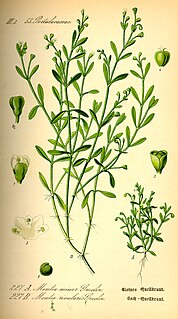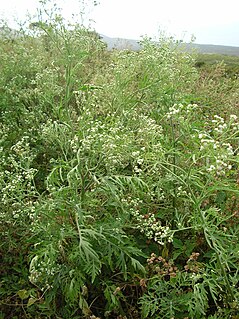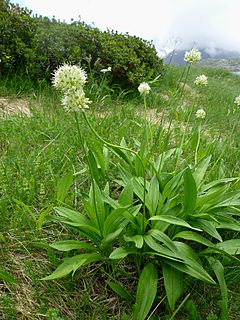
Hornbeams are hardwood trees in the flowering plant genus Carpinus in the birch family Betulaceae. The 30–40 species occur across much of the temperate regions of the Northern Hemisphere.

Xanthium (cocklebur) is a genus of flowering plants in the sunflower tribe within the daisy family, native to the Americas and eastern Asia and some parts of south Asia.

Matricaria is a genus of flowering plants in the chamomile tribe within the sunflower family. Some of the species have the common name of "mayweed," but this name also refers to plants not in this genus.

Bidens tripartita is a common and widespread species of plants in the sunflower family, Asteraceae, commonly known as three-lobe beggartick, three-part beggarticks, leafy-bracted beggarticks or trifid bur-marigold. It is native to much of Eurasia, North Africa, and North America, with naturalized populations in Australia and on some Pacific Islands.

Cyperus is a large genus of about 700 species of sedges, distributed throughout all continents in both tropical and temperate regions.

Eriophorum is a genus of flowering plants in the family Cyperaceae, the sedge family. They are found throughout the arctic, subarctic, and temperate portions of the Northern Hemisphere in acid bog habitats, being particularly abundant in Arctic tundra regions.

Helenium is a genus of annuals and herbaceous perennial plants in the family Asteraceae, native to the Americas.

Montia is a genus of plants in the family Montiaceae. Species in this genus are known generally as miner's lettuce or water chickweed. All of the species in the genus have edible leaves. It is found worldwide, except in Asia.

Parthenium is a genus of North American shrubs in the sunflower tribe within the daisy family and subfamily Asteroideae.

Iva is a genus of wind-pollinated plants in the daisy family, described as a genus by Linnaeus in 1753. Plants of this genus are known generally as marsh elders. The genus is native to North America.

Filago is a genus of plants in the sunflower family, native to Europe, Asia, and North Africa. They are sometimes called cottonroses or cudweeds.

Hypochaeris glabra is a species of flowering plant in the dandelion tribe within the daisy family known by the common name smooth cat's ear. It is native to Europe, North Africa, and the Middle East but it can be found on other continents where it is an introduced species and a widespread weed. It has become widespread in Africa, southern and southeastern Asia, Australia, and parts of the Americas.

Bidens cernua is a plant species in the sunflower family, widespread across much of Eurasia and North America. It is commonly called nodding beggarticks or nodding bur-marigold,

Polymnia is a genus of American plants in the sunflower family. It is the only genus in the tribe Polymnieae. Several species are known by the common name leafcup.

Chrysogonum is a genus of flowering plants in the daisy family found only in eastern North America. Confusion regarding species that were named in Chrysogonum from other parts of the world, such as Madagascar, was clarified by Stuessy who reduced the genus to having only a single species with two varieties. A similar treatment was proposed by Nesom, although in that treatment 3 varieties were accepted. The plants are low-growing terrestrial herbs with yellow flower heads containing both disc florets and ray florets. The genus is distinctive in having pistillate ray florets and staminate disk florets, and the pistil of the ray floret is fused to the adjacent phyllary as well as 3 paleae and their associated disk florets to form a "cypsela complex". The species is grown as an ornamental plant under the common name of Green and Gold, and is used primarily as a ground cover.

Carex hirta, the hairy sedge or hammer sedge, is a species of sedge native across Europe. It has characteristic hairy leaves and inflorescences, and is the type species of the genus Carex.

Allium victorialis, commonly known as victory onion, Alpine leek, and Alpine broad-leaf allium is a broad-leaved Eurasian species of wild onion. It is a perennial of the Amaryllis family that occurs widely in mountainous regions of Europe and parts of Asia.

Caltha natans is a species of flowering plant in the buttercup family. It goes by the common name floating marsh marigold.

Hottonia is a genus of aquatic flowering plant in the family Primulaceae. It comprises two species, both of which are known by the common name featherfoil:

Bidens bipinnata is a common and widespread species of flowering plant in the daisy family.




















